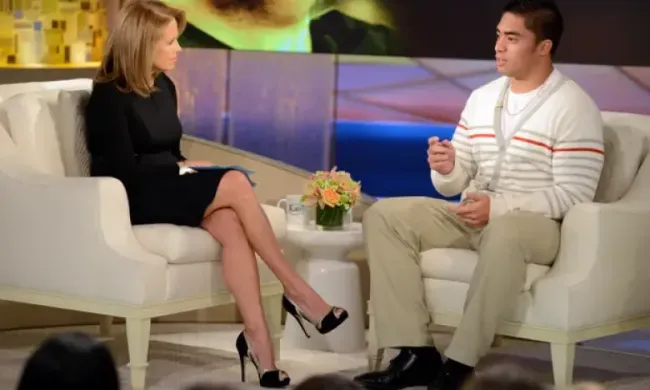Manti Teo Mormon Athlete notre dame football, manyi tao catfishing nfl drafted
The Girlfriend Who Didn't Exist is a sympathetic look back at the Manti Te'o hoax.
In a new Netflix documentary, two young people at the center of a catfishing story that captivated America are shown in many different ways.
At the beginning of 2013, sports scandals about Lance Armstrong and college football player Manti Te'o dominated the news in the United States. Armstrong's late confession that he used drugs to win all seven of his Tour de France titles told a story about the rotten heart of American success that, 40 years after Watergate, seemed almost normal. But the Te'o case seemed to be a warning about the dangers of the internet at a time when techno-optimism was still popular, before bot accounts, fake news, and online harassment were commonplace. A new two-part documentary about Te'o's situation, which will be released on Netflix on Tuesday, says that the scandal needs to be seen as more than just a story about catfishing, which is how it's often told. As told in The Girlfriend Who Didn't Exist, the romantic hoax that led to Te'o's national shame was really about deeper and more interesting questions of identity, faith, and belonging in early 21st-century America, especially for minorities.
Even though the story became a meme almost a decade ago, most people still know the basics of the Te'o scandal: Te'o, a star linebacker for Notre Dame who is half Samoan and half Hawaiian, said that his grandmother and girlfriend both died on the same day in December 2012. Te'o got a lot of support from people all over the country, which pushed him to do even better on the field. Notre Dame went undefeated during the regular season, and Te'o seemed destined to be a first-round pick in the 2013 NFL draft. But there was one problem, and in January 2013, it was all over the news: Te'o's girlfriend, Lennay Kekua, did not exist. In reality, Kekua, who said he was a student at Stanford and with whom Te'o had an online relationship, was made up by a young man from Seattle who, like Te'o, was of Samoan descent.
For Te'o, the change happened quickly and was rough. He went from being a sports star who was on the cover of Sports Illustrated to a joke around the world in a matter of hours.
As the story spread across the internet, Teo'o was portrayed as both a fool and a possible liar. Saturday Night Live showed Teo'o telling a newscaster about the moment he found out Lennay was dead: "A couple of months ago, she called me up and said, 'Hey, I have some bad news: I'm dead.' I said, 'Oh no, do you need a ride to the funeral?'" Many pundits thought There was a dirty undercurrent of homophobia in the way Te'o's trauma was covered, analyzed, and gawked at. For example, sportswriter Mike Florio said on MSNBC's The Ed Show, "Teams want to know if Manti Te'o is gay or not. They just want to know."), while one news story added some racism to the mix by calling the whole thing a "weird Polynesian plot to make Te'o look bad."

The Girlfriend Who Didn't Exist goes through all of this history and shows Te'o to be what he probably has always been: a basically good, hard-working, deeply religious Mormon young man who was maybe a little too naive for the age of internet weaponization. In one scene, Te'o talks about how he went to his lawyer uncle for help after Lennay, who he thought was dead, called him in late December 2012 to tell him she was still alive. "Right away, my uncle said, 'I think you're being tricked.' And that was the first time anyone ever used the word "catfish." I didn't know what it meant to "catfish." Even after he told me what it was, I couldn't figure out what that meant."
The hoaxer, Naya Tuiasosopo, who has since come out as a trans woman and uses she/her pronouns, made up Lennay and gave her a Facebook profile with photos stolen from a former high school classmate and a whole group of extended family members and friends. The first time Te'o was contacted, it was through this Facebook account. It was only because Tuiasosopo was so good at making the female voice sound like a male voice that the relationship lasted for months of texting and phone calls.
A note at the beginning of each episode of The Girlfriend Who Didn't Exist says, "At the time of filming, subjects were not aware that [Tuiasosopo] identifies as a transgender woman." The show has a lot of new interview footage with both Te'o and Tuiasosopo. Because of this, most of the people in the documentary accidentally dead-name Tuiasosopo. This seems like a shame, since the most interesting part of the series is how it shows Tuiasosopo's state of mind when he was pulling off the hoax. When Tuiasosopo made Lennay, she was feeling very confused about who she was. This is clear from the portrait.
She says, "The Lennay profile wasn't always a way out, but it was a way to something else." "At that time, I knew for sure that something inside me wanted to scream out, "Why am I different?" There were a few times when I met someone online and thought, "This guy is cute. Let's see how this turns out.' I knew what was right and what was wrong, but I liked being looked at this way too much. Even though it was all about me, it was what made me happy. It was what I hoped would happen."
The only thing that kept Te'o and Lennay/Naya together was their shared background, not the internet itself, which was just a tool in the story. Even though Lennay was made up, Tuaisosopo gave the character her own interests, music tastes, and, most importantly, her own ethnicity. Both Te'o and Tuiasosopo are young Samoans who are now in their early 30s. When they were young, they were trying to balance the responsibilities of family and faith, which are important parts of Samoan culture, with the sometimes conflicting demands of life in the United States.
Football is often the way that Samoan-Americans connect to the larger culture around them. Tuiasosopo's dad played football at USC, her uncle played for the Rams, and her cousin played for the Raiders. As a child, she threw herself into football to live up to that legacy.
In The Girlfriend Who Didn't Exist, she says, "But I hate football." "I only wanted to play football because I was told to and because I wanted my dad to be happy. But I really did feel the weight of fear. I didn't have the guts to just say, "Look, this is who I am." I really thought that, since I was born a man, I could never be who I wanted to be. That's when I decided I would be able to live as a woman, even if it was just for a little while.
Te'o had a different experience. He loved football from the start, and as a high school player, it was clear that he was going to do great things. As their online relationship grew, Lennay even gave Te'o advice on how to improve his defense by sending him text messages like "I encourage you, babe, to control the pace and flow of your defense." Tuiasosopo says, "Because we could talk about these things, Lennay became a rock for him."
But it's their shared background and goals that make Te'o and Tuiasosopo's story so interesting, no matter how sad it ends up being. Whether they did it to rebel against football or in cooperation with it, both of them used football as a canvas to show how they would fit in as ethnic minority kids in white-dominated America.
After the scandal broke, Tuiasosopo moved back to American Samoa and found support from the LGBTQ community there. There is also a large and well-established group of people who identify as fa'afafine, which means third gender or non-binary.
She says, "I just had to start living my life." "And I wanted to live my life as a trans person. I still feel terrible about what happened, and sometimes I wish I could take it all back. But then another part of me was like, "The lessons I learned from Lennay's life taught me so much about who I am and who I want to be."
Since the hoax got out, the years may not have been as good for Te'o. He had three pretty good seasons with the San Diego Chargers after being picked in the second round of the 2013 draft, but he played his last NFL game in 2019. In 2013, he felt his whole body go numb in the minutes before his first preseason game with the Chargers.
"That's how the first three years at the Chargers went. It was so different from that kid at Notre Dame. I was king of the football field, you know. I feel like no one can beat me when I'm playing football, for example. And I played freely, quickly, and with a lot of force. He says, "That's what made me great. "Now that I'm in the NFL, I have doubts about everything. Every day, all I did was try to figure out how to stop feeling anxious, numb, and tingly. I'm trying to figure out how to change all of these things about myself." He finally went to see a therapist, who told him to forgive himself for the hoax. "What happened to you is not your fault," the therapist told him.
Even though that was a big step forward, the documentary shows that Te'o's experience is still a source of deep trauma for him: "I'll take all this crap," he says. "I'll take all the jokes and all the memes so I can be an inspiration to the one who needs me to be." Hopefully, by talking about their pain so openly, both Te'o and Tuiasosopo will find some peace as they try to start over in their still-young lives and find their own place in the violent chaos of America in the 2020s.
